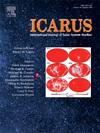Observability of radio reflections from exoplanet ionospheres with next generation radio telescopes
IF 2.5
2区 物理与天体物理
Q2 ASTRONOMY & ASTROPHYSICS
引用次数: 0
Abstract
Much has been learned about exoplanets and their atmospheres in the last three decades with the help of highly sensitive optical telescopes. Limited observations using X-ray telescopes have revealed the presence of ionospheres with very high density plasma around the hot Jupiter HD189733b. Owing to high density, the cutoff frequency of this plasma would lie in the range of few GHz. As the planet goes around the star, we suggest it might be possible to capture the stellar radio emission reflected from the ionosphere of the planet. We find that the reflected spectrum has a slope which is representative of the plasma density profile of the ionosphere and has a cutoff frequency. After investigating the reflection and free-free absorption process in the ionosphere, we find that this reflected signal, though feeble, can be captured by very sensitive radio telescopes operating in the low frequency range. We estimate the reflected signal from the ionosphere of a hot Jupiter and find that the flux ratio of the planet to the star are about . In the view of development of facilities like Square Kilometer Array, it might be possible to capture the reflected radio signal from the ionosphere and constrain the thermal state of the ionosphere.
用新一代射电望远镜观测系外行星电离层的射电反射
在过去的三十年里,在高灵敏度光学望远镜的帮助下,人们对系外行星及其大气有了很多了解。利用x射线望远镜进行的有限观测显示,热木星HD189733b周围存在密度极高的等离子体电离层。由于密度高,这种等离子体的截止频率将在几GHz的范围内。当行星围绕恒星运行时,我们认为有可能捕捉到从行星电离层反射的恒星无线电发射。我们发现反射光谱有一个斜率,它代表了电离层的等离子体密度分布,并且有一个截止频率。在研究了电离层的反射和自由-自由吸收过程后,我们发现这种反射信号虽然微弱,但可以被工作在低频范围内的非常灵敏的射电望远镜捕获。我们估计了来自热木星电离层的反射信号,发现行星与恒星的通量比约为0.01%。从平方公里阵列等设施的发展来看,有可能从电离层捕获反射的无线电信号,并约束电离层的热状态。
本文章由计算机程序翻译,如有差异,请以英文原文为准。
求助全文
约1分钟内获得全文
求助全文
来源期刊

Icarus
地学天文-天文与天体物理
CiteScore
6.30
自引率
18.80%
发文量
356
审稿时长
2-4 weeks
期刊介绍:
Icarus is devoted to the publication of original contributions in the field of Solar System studies. Manuscripts reporting the results of new research - observational, experimental, or theoretical - concerning the astronomy, geology, meteorology, physics, chemistry, biology, and other scientific aspects of our Solar System or extrasolar systems are welcome. The journal generally does not publish papers devoted exclusively to the Sun, the Earth, celestial mechanics, meteoritics, or astrophysics. Icarus does not publish papers that provide "improved" versions of Bode''s law, or other numerical relations, without a sound physical basis. Icarus does not publish meeting announcements or general notices. Reviews, historical papers, and manuscripts describing spacecraft instrumentation may be considered, but only with prior approval of the editor. An entire issue of the journal is occasionally devoted to a single subject, usually arising from a conference on the same topic. The language of publication is English. American or British usage is accepted, but not a mixture of these.
 求助内容:
求助内容: 应助结果提醒方式:
应助结果提醒方式:


